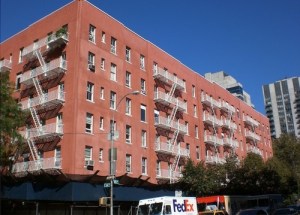UES Landlord and Preservation Group to Meet Before LPC Over Apartment Demolitions
By Billy Gray June 11, 2013 7:45 am
reprintsAn Upper East Side landlord seeking to demolish two landmark buildings under a hardship application claiming that the properties cannot fetch rents of $600 a month is gearing up for a fight with Friends of the Upper East Side Historic District.
A hearing today before the Landmarks Preservation Commission could end the dispute between Stahl York Avenue and the neighborhood preservation group.

FRIENDS UESHD has prepared an exhaustive rebuttal to Stahl’s claims that 429 East 64th Street and 430 East 65th Street qualify for the hardship provision, which allows the demolition of landmark buildings in the cases of true economic distress. A FRIENDS-prepared statement says the owner submitted an application to the LPC claiming the properties do not generate a 6 percent profit and that, following a $4 million renovation, Stahl would not be able to charge average rents of $600 a month at the buildings. Together, the properties hold 190 units, many of them currently occupied by an aged, low-to-moderate income tenancy.
After a $17-million investment, Stahl now says it can achieve an average $1,235 monthly rent. A study commissioned by FRIENDS and done by HR&A Advisors determined that the buildings could “easily rent” for $1,500 a month and make an 11.7 percent annual return.
If the LPC does grant Stahl a certificate of appropriateness and the buildings are demolished, FRIENDS Executive Director Tara Kelly said “what would happen is up to [Stahl]. From our point of view this is a threat to landmark properties. The hardship provision is intended for relief from a real economic hardship. This is not that case.” Ms. Kelly conceded that rent controlled and stabilized units in the buildings keep rents down, but that $1,500 is the market, “not legal” figure and that portions of the $4 million renovation can be channeled through tenants.
Stahl purchased the buildings in 1977 from Rockefeller University. A long, strange trip toward designation begin in the early ’80s. Dedesignation and redesignation followed. Between 1990 and 2006, the years the buildings were not designated, Ms. Kelly claims Stahl “defaced” the facade by covering it in pink stucco.
“Hopefully this hearing is the end,” Ms. Kelly said. “But I don’t believe that there will be a vote tomorrow. I’m not sure how much time that would take. As with anything else, it’s absolutely possible that there could be another go-around. Everyone’s hoping that this will be the end.”
The Commercial Observer called Stahl for comment. A representative answered, but said he “was only here for emergencies” and to call another time.



